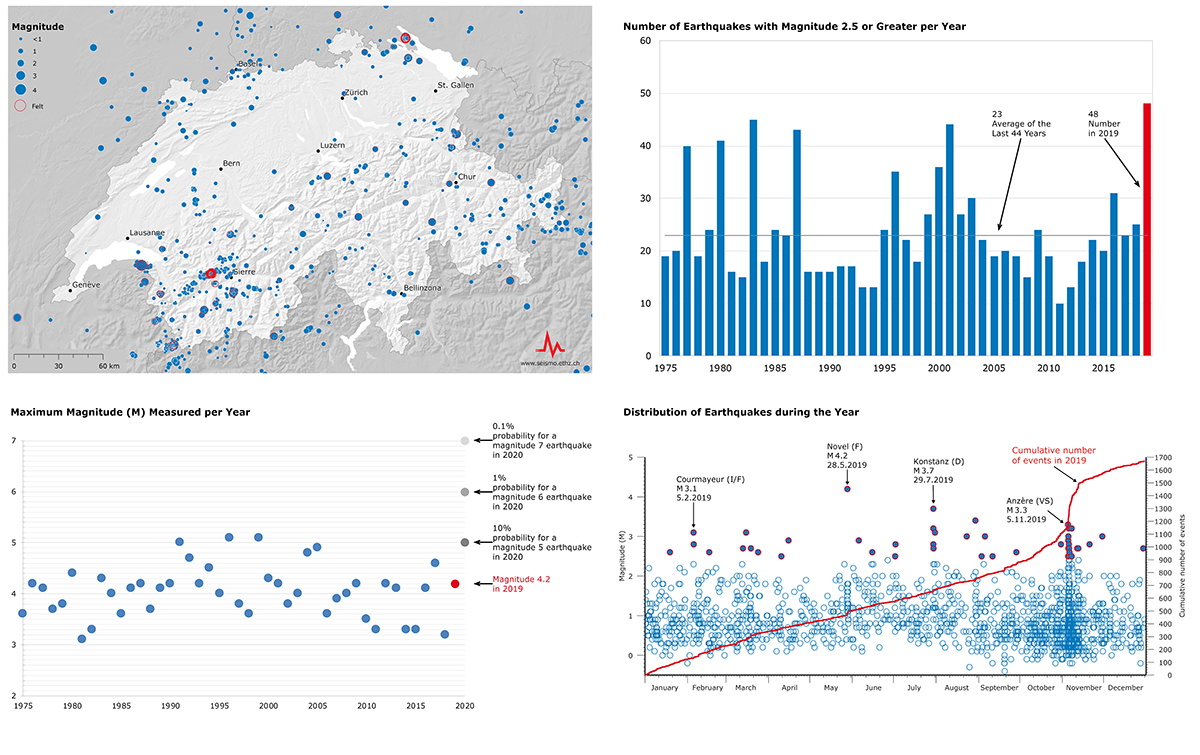2020-01-14
Earthquakes in Switzerland in 2019
Last year, twice as many earthquakes occurred in Switzerland and in neighbouring countries compared to the long-term average. For nearly 50 of the total of 1,670 recorded earthquakes, the Swiss Seismological Service (SED) at ETH Zurich received five or more felt reports. Most of the quakes can be attributed to five active earthquake sequences that shaped seismic activity in 2019. One of them was in the canton of Valais, in the area between Anzère and the Sanetsch Pass. The other four occurred just over the Swiss border, at Courmayeur (Italy), Novel (France), Konstanz (Germany) and Chamonix (France).
In Switzerland, earthquakes often occur in sequences referred to as 'earthquake swarms', i.e. clusters of tremors occurring over time at one, specific location. An unusual feature of last year's seismic activity was the number of highly active earthquake sequences leading to a never previously recorded amount of events since modern seismic monitoring began in the 1970s. This also resulted in more felt earthquakes than usual. As a rule, quakes felt by humans have usually a magnitude of 2.5 or more. The last time a similar cluster of felt quakes occurred was back in 1964, when Sarnen, in the canton of Obwalden, experienced a distinct sequence of earthquakes over a period of several months, with magnitudes of up to 5.3. Although such a high level of earthquake activity as that experienced in 2019 is rare, it is neither unexpected, nor a sign of an increased seismic hazard over the months and years to come.
Read more...An earthquake swarm comprising 16 quakes in the canton of Valais prompted some 2,000 reports by members of the public who had felt them, the highest level of public attention gained all year. During the first half of November, more than 300 quakes occurred north of Sion, between Anzère and the Sanetsch Pass. The two largest events had a magnitude of 3.3. Initial analyses suggest that during this sequence several simultaneously activated faults influenced each other. By contrast, the seismic activity on the Bodanrück peninsula near Konstanz (Germany) appears to have been associated with a single activated structure in the geological underground. All the quakes there share a similar rupture mechanism. This swarm, comprising a total of seven felt earthquakes, indicates a seismically active fault structure in the Hegau-Bodensee region.
The largest earthquake in 2019, with a magnitude of 4.2, occurred at the end of May as part of the earthquake swarm near Novel (France). The SED received 600 felt reports for this event alone. The second strongest quake, with a magnitude of 3.7, occurred in connection with the swarm near Konstanz (Germany). The largest cluster of events in 2019 (410 quakes in all) was associated with the long-standing active sequence near Courmayeur (Italy) in the area of the Mont Blanc massif.
The overall total of 1,670 recorded earthquakes is a new record. But this high number is not only due to the high level of earthquake activity in the past year, but can also be attributed to the steady densification and modernisation of the seismic network. For seismologists, it is helpful for more earthquakes to be recorded, because such measurements enable them to produce an ever more detailed picture of the Alps' geological underground and seismotectonics. Among other things, this can help to improve the basis for future seismic hazard and risk assessments.
